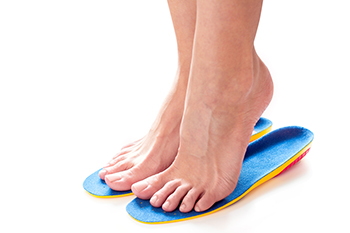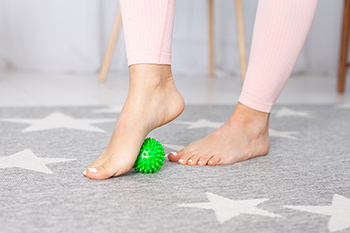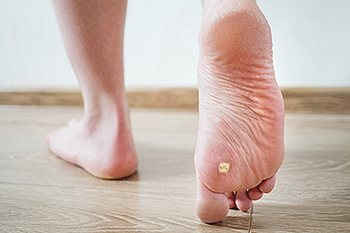Connect With Us
Blog
Items filtered by date: June 2023
Various Types of Bunions

Research has shown that bunions are the most common medical condition that affects the front of the foot. It is easy to notice by the large bump that develops and protrudes on the side of the big toe. Severe bunions may cause the other toes to shift together, and larger shoes may need to be purchased. A bunion is considered to be a deformity and can happen from wearing shoes that do not have ample room for the toes to move freely in. High heels can fit into this category, and it is helpful to limit how frequently they are worn. There are various types of bunions, and a simple bunion is a bump on the side of the big toe joint. The same bunion may have skin irritation from rubbing against the shoes and a tailor’s bunion forms on the pinky toe. Bunions with hallux limitus can change the structure of the foot, which may cause the bunion to form on the top instead of on the side of the foot. Some people can help to wear a protective pad over the bunion for mild relief. If you have a bunion, it is strongly suggested that you visit a podiatrist who can offer you treatment options that are correct for you.
If you are suffering from bunion pain, contact Jeffrey L. Bober, DPM of Maryland. Our doctor can provide the care you need to keep you pain-free and on your feet.
What Is a Bunion?
Bunions are painful bony bumps that usually develop on the inside of the foot at the joint of the big toe. As the deformity increases over time, it may become painful to walk and wear shoes. Women are more likely to exacerbate existing bunions since they often wear tight, narrow shoes that shift their toes together. Bunion pain can be relieved by wearing wider shoes with enough room for the toes.
Causes
- Genetics – some people inherit feet that are more prone to bunion development
- Inflammatory Conditions - rheumatoid arthritis and polio may cause bunion development
Symptoms
- Redness and inflammation
- Pain and tenderness
- Callus or corns on the bump
- Restricted motion in the big toe
In order to diagnose your bunion, your podiatrist may ask about your medical history, symptoms, and general health. Your doctor might also order an x-ray to take a closer look at your feet. Nonsurgical treatment options include orthotics, padding, icing, changes in footwear, and medication. If nonsurgical treatments don’t alleviate your bunion pain, surgery may be necessary.
If you have any questions, please feel free to contact our office located in Glen Burnie, MD . We offer the newest diagnostic and treatment technologies for all your foot care needs.
Various Types of Orthotics

Orthotics are inserts that are put inside the shoes which can help to correct problematic foot structures. People who have flat feet, high arches, or foot conditions such as arthritis and plantar fasciitis may benefit from wearing orthotics. Soft, rigid, and semi-rigid are the different types of orthotics to choose from, and each kind is designed to provide the desired results for the specific foot condition. Soft orthotics may provide cushioning that can help to absorb shock, in addition to reducing pressure while walking. Plastic or graphite materials are used to make rigid orthotics, which and may help to improve alignment and movement. The most common types of orthotics are semi-rigid and are constructed with flexible materials that lie over a firm bottom layer. People who have diabetes may wear orthotics as a method of preventing sores or blisters from developing. If you would like to have more knowledge about orthotics, it is suggested that you confer with a podiatrist who can provide you with the information you are seeking.
If you are having discomfort in your feet and would like to try orthotics, contact Jeffrey L. Bober, DPM from Maryland. Our doctor can provide the care you need to keep you pain-free and on your feet.
What Are Orthotics?
Orthotics are inserts you can place into your shoes to help with a variety of foot problems such as flat feet or foot pain. Orthotics provide relief and comfort for minor foot and heel pain but can’t correct serious biomechanical problems in your feet.
Over-the-Counter Inserts
Orthotics come in a wide variety of over-the-counter inserts that are used to treat foot pain, heel pain, and minor problems. For example, arch supports can be inserted into your shoes to help correct overarched or flat feet, while gel insoles are often used because they provide comfort and relief from foot and heel pain by alleviating pressure.
Prescription Orthotics
If over-the-counter inserts don’t work for you or if you have a more severe foot concern, it is possible to have your podiatrist prescribe custom orthotics. These high-quality inserts are designed to treat problems such as abnormal motion, plantar fasciitis, and severe forms of heel pain. They can even be used to help patients suffering from diabetes by treating foot ulcers and painful calluses and are usually molded to your feet individually, which allows them to provide full support and comfort.
If you are experiencing minor to severe foot or heel pain, it’s recommended to speak with your podiatrist about the possibilities of using orthotics. A podiatrist can determine which type of orthotic is right for you and allow you to take the first steps towards being pain-free.
If you have any questions please contact our office located in Glen Burnie, MD . We offer the newest diagnostic and treatment technologies for all your foot and ankle needs.
Two Groups of Foot Muscles

People who frequently go to the gym understand the importance of exercising the muscles in their bodies. With this being noted, the feet are often neglected, and many people fail to properly stretch and exercise their feet. The muscles in the feet can be categorized into two different areas, and the intrinsic foot muscles can be referred to as the core of the feet. The arch is maintained by these muscles and can aid in shock absorption. Global muscles are typically larger, and the ankle is moved by these types of muscles, which are also responsible for pointing and flexing the toes. Common exercises to perform consists of picking up marbles with the toes. This stretch can engage both groups of muscles. A strengthening exercise for the toes can be done by spreading them out as far as possible, repeated several times. If you would like more information about how foot exercises can benefit the feet, it is suggested that you speak with a podiatrist who can guide you toward effective foot stretches to perform.
Exercising your feet regularly with the proper foot wear is a great way to prevent injuries and build strength. If you have any concerns about your feet, contact Jeffrey L. Bober, DPM from Maryland. Our doctor can provide the care you need to keep you pain-free and on your feet.
Exercise for Your Feet
Exercise for your feet can help you gain strength, mobility and flexibility in your feet. They say that strengthening your feet can be just as rewarding as strengthening another part of the body. Your feet are very important, and we often forget about them in our daily tasks. But it is because of our feet that are we able to get going and do what we need to. For those of us fortunate enough to not have any foot problems, it is an important gesture to take care of them to ensure good health in the long run.
Some foot health exercises can include ankle pumps, tip-toeing, toe rises, lifting off the floor doing reps and sets, and flexing the toes. It is best to speak with Our doctor to determine an appropriate regimen for your needs. Everyone’s needs and bodies are different, and the activities required to maintain strength in the feet vary from individual to individual.
Once you get into a routine of doing regular exercise, you may notice a difference in your feet and how strong they may become.
If you have any questions please feel free to contact our office located in Glen Burnie, MD . We offer the newest diagnostic and treatment technologies for all your foot and ankle needs.
Treatment Options for Plantar Warts

A plantar wart is a growth that develops on the sole of the foot. The wart is caused by coming into contact with the human papillomavirus, or HPV. Plantar warts are most commonly seen on the ball or heel of the foot. Because these two areas take the force of your weight, the wart may become hardened and look like a callus. It also may contain tiny black dots that are actually dried up or clotted capillaries. Plantar warts are contagious and should not be touched, if possible, because they can be spread to other body parts. Treatment options range from applying salicylic acid to remove the wart layer by layer to removing the wart at one time by surgery. Additional treatments of plantar warts include spraying with liquid nitrogen and laser therapy to burn off the wart. Each type of treatment brings with it certain painful or annoying side effects, and the methods take varied amounts of time to get the best result. For help with a plantar wart, it is suggested that you make an appointment with a podiatrist who can prescribe the treatment that will work best for you.
Plantar warts can be very uncomfortable. If you need your feet checked, contact Jeffrey L. Bober, DPM from Maryland. Our doctor will assist you with all of your foot and ankle needs.
About Plantar Warts
Plantar warts are the result of HPV, or human papillomavirus, getting into open wounds on the feet. They are mostly found on the heels or balls of the feet.
While plantar warts are generally harmless, those experiencing excessive pain or those suffering from diabetes or a compromised immune system require immediate medical care. Plantar warts are easily diagnosed, usually through scraping off a bit of rough skin or by getting a biopsy.
Symptoms
- Lesions on the bottom of your feet, usually rough and grainy
- Hard or thick callused spots
- Wart seeds, which are small clotted blood vessels that look like little black spots
- Pain, discomfort, or tenderness of your feet when walking or standing
Treatment
- Freezing
- Electric tool removal
- Laser Treatment
- Topical Creams (prescription only)
- Over-the-counter medications
To help prevent developing plantar warts, avoid walking barefoot over abrasive surfaces that can cause cuts or wounds for HPV to get into. Avoiding direct contact with other warts, as well as not picking or rubbing existing warts, can help prevent the further spread of plantar warts. However, if you think you have developed plantar warts, speak to your podiatrist. He or she can diagnose the warts on your feet and recommend the appropriate treatment options.
If you have any questions please feel free to contact our office located in Glen Burnie, MD . We offer the newest diagnostic and treatment technologies for all your foot and ankle needs.
Blog Archives
- October 2024
- September 2024
- August 2024
- July 2024
- June 2024
- May 2024
- April 2024
- March 2024
- February 2024
- January 2024
- December 2023
- November 2023
- October 2023
- September 2023
- August 2023
- July 2023
- June 2023
- May 2023
- April 2023
- March 2023
- February 2023
- January 2023
- December 2022
- November 2022
- October 2022
- September 2022
- August 2022
- July 2022
- June 2022
- May 2022
- April 2022
- March 2022
- February 2022
- January 2022
- December 2021
- November 2021
- October 2021
- September 2021
